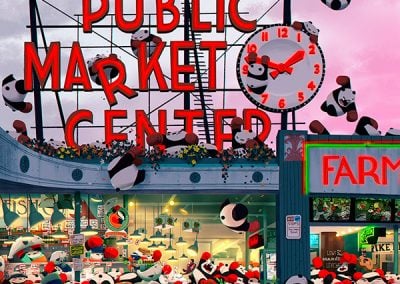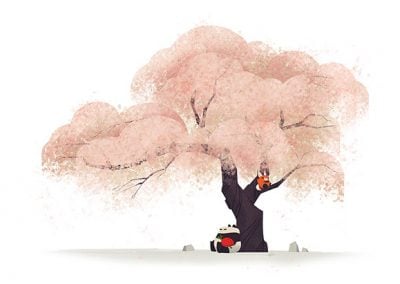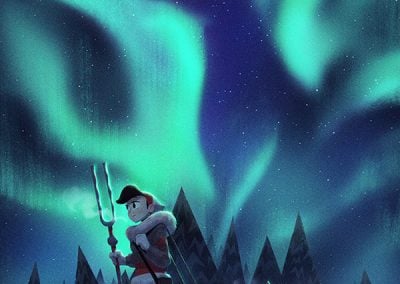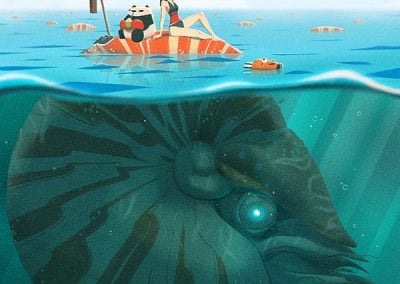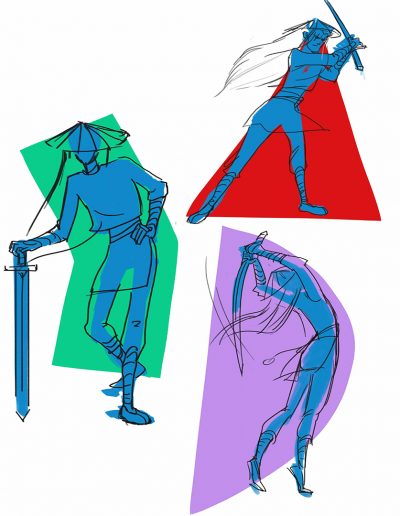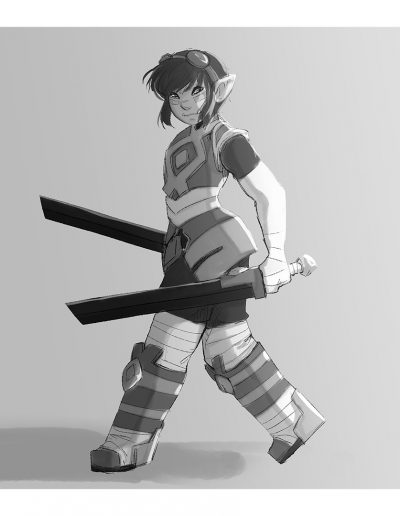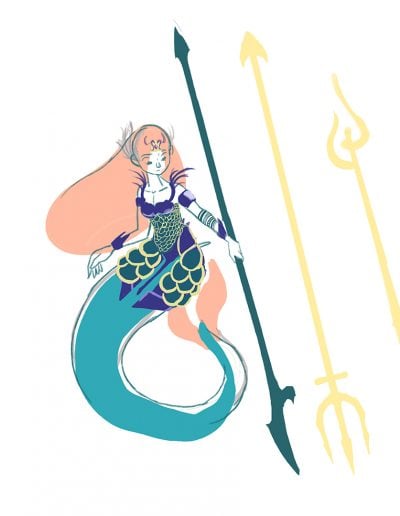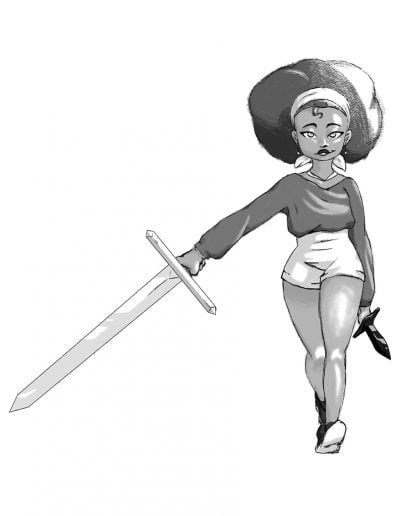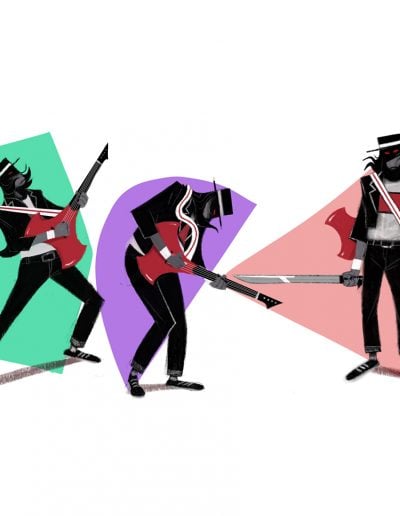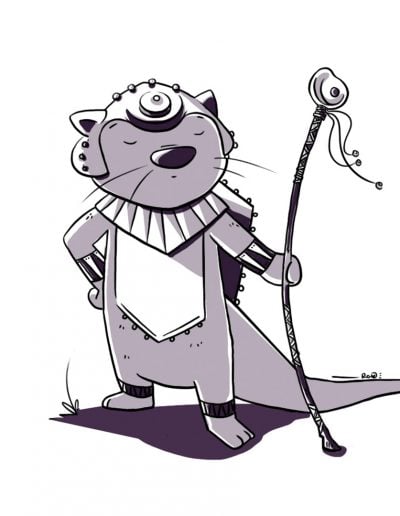Visual Development Course: Principles of Design
Use shape design principles to enhance your designs in this 6-week workshop
VISUAL DEVELOPMENT ARTISTS CREATE NEW WORLDS
In animated films and video games, every prop, location, or character you see on the screen was designed by a visual development artist. These artists focus on developing and identifying the look and feel for animated films and games. If the story calls for the main character to have an accessory, like a sword, an artist will be responsible for creating the look and feel of that object. They’ll start by creating many variations and options for the art director to review. They’ll use shape language appropriate to the show to help ensure the prop feels like it should belong to the main character and exist in that world.
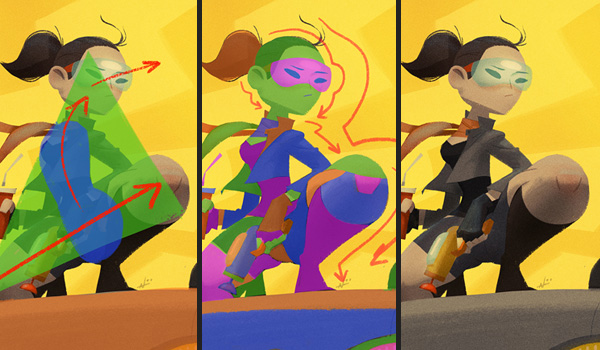
Understanding Shapes and Positive/Negative Space in Visual Development
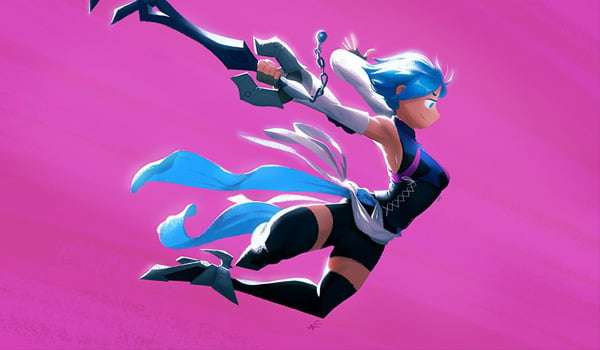
Drawing by Nolen Lee
Artists are visual communicators, and learning the vocabulary of that language is an important part of the process. This includes ideas around composition, color theory, character design, perspective and more. These are all building blocks and fundamental elements that visual development artists can utilize to help create compelling assets for the rest of the production.
Whether you’re interested in pursuing character or environment design, becoming a concept artist, or you’re an animator hoping to strengthen your poses and overall skills, mastering the fundamental principles of design is a worthwhile goal. The techniques, theories, and skills you’ll learn in this workshop can be applied to any visual or spatial medium: games, virtual reality, animation, you name it.
6-WEEK COURSE
$899 USD
Pro Artists Mentor You to Be Successful
Our visual development course allows you to learn, practice, and get 1:1 feedback and reviews from our mentors. You will have the chance to learn from them in live conversations as they share insights about what studios are working on and what qualities they look for in an visual artist. Our mentors will work directly with you to grow and improve your skills.


Nolen Lee
Freelance Artist
Punching Pandas
Nolen Lee is a freelance illustrator, artist, and author based in the Seattle area. He is the creator of his own whimsical and humorous brand, The Punching Pandas, and has self-published two books, The Panda is Fat and The Panda is Still Fat.
He has also worked on numerous freelance projects including comics for Disney and commercial illustration for clients such as US Bank, AARP, US Census, as well as various charities. His background in structural engineering informs his art teaching style which emphasizes practicality and simplicity. He continues to develop his own projects including animation and children's book illustration. You can view more of his work on his website.
Sign Up for Our Waiting List
Sign up for our waiting list and we'll notify you when more seats are available or when the next registration opens.
Choose Your Mentor
Review available mentors and Q&A times. All Q&A times shown in Pacific time.
Examples of Nolen’s Work
Click and scroll through images to enlarge
1-on-1 Feedback from a Studio Pro
During this 6-week workshop, you’ll have live Q&As with your mentor each week in addition to receiving an assignment designed to build your skills. Plus, your mentor will review and critique each of your assignments and provide you with a video of their feedback so you can improve your work.
How the Pros Use Shapes to Create Worlds
Good shape design creates the look and feel of an environment. By understanding how different shapes inject personality and emotion into scenes, a visual development artist helps create worlds complete with story arcs, heroes, villains, and sidekicks that audiences love.
Visual Development: Principles of Design Student Gallery
Click and scroll through images to enlarge
What You’ll Learn in Visual Development Course: Principles of Design
Week 1
Why: Seeing Shapes
Before we can design, we must learn what it means to see. In this first lesson we will learn how to train our eyes to see shapes in the visual world—developing observation skills and learning to see shapes within complex forms.
Week 2
What: Shape Types
In the previous session, we learned to visualize shapes in the world around us. In this session, we will explore the different varieties of shapes and how to search for them. We’ll also learn how to simplify complex objects into simple shapes.
Week 3
How: Design Basics
We learned how to look for shapes and the different types of shapes. Now it’s time to apply our analytical skills to our designs. In this session, we will learn the basics of visual design and how to apply them to our art.
Week 4
Who: Emoting with Shapes
Not only can shapes create a unified design, they can also add emotion and personality into our work. In this session, we will cover the psychology of shapes and how to incorporate that into character design.
Week 5
Where: Using Shapes to Create a Simplified Environment
We learned how to inject personality and emotion into our characters using shapes, now it’s time to apply the same principles to environments and compositions.
Week 6
Taking Shapes Beyond
In this final session, we will cover how shape design can be applied to multiple applications such as illustration, animation, games, and beyond.
Course Requirements for Visual Development: Principles of Design
Course Details
LIVE Q&As | Weekly 1-Hour Q&As
ASSIGNMENTS | 5 Design Exercises
SOFTWARE | Painting software for assignments (Adobe Photoshop or equivalent software). Students may work traditionally if desired, but must be able to photograph or scan assignments.
HARDWARE | Meet Minimum Requirements
AGE | 18 Years or Older
LANGUAGE | Taught in English
Skills You Need Before You Start
This workshop is open to students with basic drawing skills, but is not graded so that you feel comfortable learning the concepts at your own pace. It’s a good fit for animators wanting to learn more about the visual development stages of the animation pipeline, and anyone interested in a career in concept art.
What You’ll Learn
If you’re interested in pursuing visual development or becoming a concept artist, or you’re an animator hoping to strengthen your poses and overall skills, mastering the fundamental principles of design is a worthwhile goal.
The techniques, theories, and skills you’ll learn in this workshop can be applied to any visual or spatial medium: video games, virtual reality, animation—you name it.
After finishing our workshop, you will have gained the following skills, which are essential for any visual development artist or visual designer:
- Stronger understanding of posing that can be applied to visual mediums from character design, to painting, to 3D animation
- Fluency with shape language and design, allowing you to create interesting and unique visual imagery
- Ability to simplify designs down to their essential elements for clarity and appeal
- Fundamentals of character design and presentation, allowing you to create appealing and unique characters
FAQ for Visual Development Course
Do visdev artists create characters?
Yes, a visual development artist can create characters. Character development is one of the many skills a visdev artist must have.
What does a visdev artist do?
A visual development artist is the person who creates the overall feel and mood of the project. While visdev artists have many responsibilities, their main tasks are to create and document the color palette, mood, and tone of the entire world of the project.
What’s the difference between a visual development artist and a character designer?
The main difference between the two is that character designers are specifically focused on creating and designing characters. Visdev artists may be tasked with creating characters or they may work on creating props, sets, environments, and backgrounds.
Can visdev artists work on anything else besides characters?
Yes, in fact a visdev artists will almost certainly work on other parts of the project in addition to character development.
What else falls under visdev besides character design?
Environment design, backgrounds, buildings, sets, props and assets are all parts of the visual development of the project.
Is character design a sub-category of visdev?
Yes, visdev artists work on character design, environment design, and the overall style and feel of the project.
What Visual Development Students are Saying
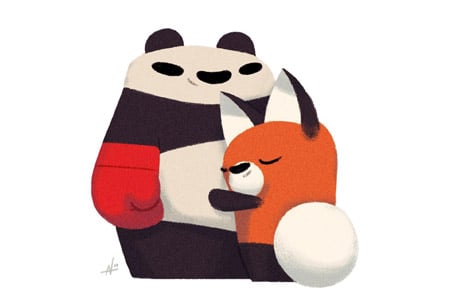
Nolen Lee is Phenomenal
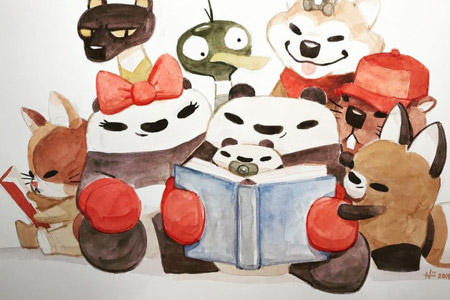
Focused on Character Design
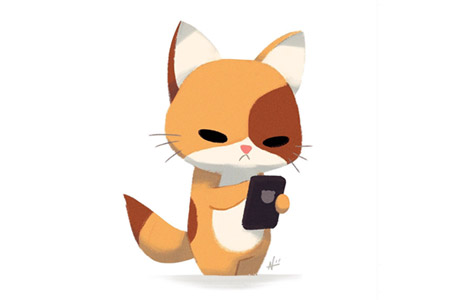
Great Intro to Design
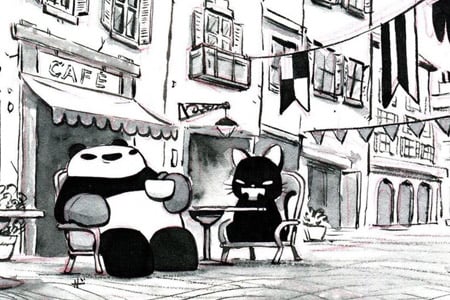
I Learned a Lot from Nolen

Nolen Lee is Phenomenal

Focused on Character Design

Great Intro to Design

I Learned a Lot from Nolen
Related Courses
If you’re interested in Concept Art, we think you’ll love these courses!
Introduction to Character Design
6-Week course
Learn the fundamentals of character design.
Introduction to
Digital Painting
6-Week course
Learn digital painting techniques and create your own works of art.
Story I: Storyboarding
Fundamentals
6-Week COURSE
Sophisticate your storyboarding craft and add core skills & techniques to your tool box.
Story II: Intermediate Storyboarding
6-Week COURSE
Building on foundations, further develop your storytelling & story development skillsets.
